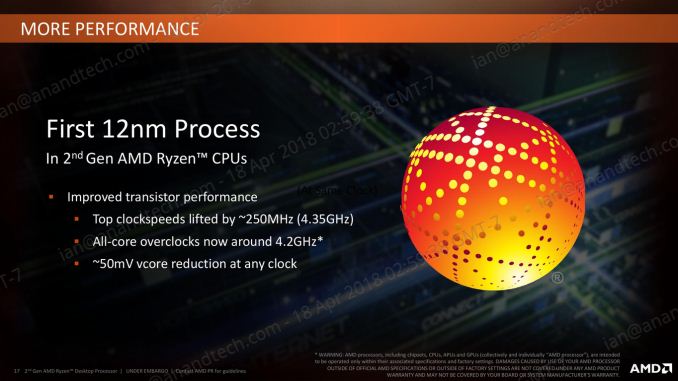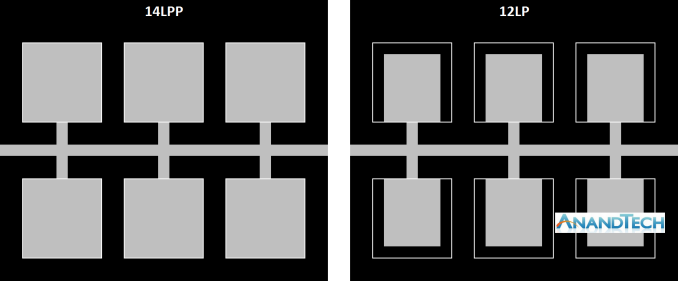The AMD 2nd Gen Ryzen Deep Dive: The 2700X, 2700, 2600X, and 2600 Tested
by Ian Cutress on April 19, 2018 9:00 AM ESTTalking 12nm and Zen+
One of the highlights of the Ryzen 2000-series launch is that these processors use GlobalFoundries’ 12LP manufacturing process, compared to the 14LPP process used for the first generation of Ryzen processors. Both AMD and GlobalFoundries have discussed the differences in the processes, however it is worth understanding that each company has different goals: AMD only needs to promote what helps its products, whereas GlobalFoundries is a semiconductor foundry with many clients and might promote ideal-scenario numbers. Earlier this year we were invited to GlobalFoundries Fab 8 in upstate New York to visit the clean room, and had a chance to interview Dr. Gary Patton, the CTO.
The Future of Silicon: An Exclusive Interview with Dr. Gary Patton, CTO of GlobalFoundries
In that interview, several interesting items came to light. First, that the CTO doesn’t necessarily have to care much about what certain processes are called: their customers know the performance of a given process regardless of the advertised ‘nm’ number based on the development tools given to them. Second, that 12LP is a series of minor tweaks to 14LPP, relating to performance bumps and improvements that come from a partial optical shrink and a slight change in manufacturing rules in the middle-line and back-end of the manufacturing process. In the past this might not have been so news worthy, however GF’s customers want to take advantage of the improved process.
Overall, GlobalFoundries has stated that its 12LP process offers a 10% performance improvement and a 15% circuit density improvement over 14LPP.
This has been interpreted in many ways, such as an extra 10% frequency at the same power, or lower power for the same frequency, and an opportunity to build smaller chips.
As part of today’s launch, AMD has clarified what the move to 12LP has meant for the Ryzen 2000-series:
- Top Clock Speeds lifted by ~250 MHz (~6%)
- All-core overclocks around 4.2 GHz
- ~50 mV core voltage reduction
AMD goes on to explain that at the same frequency, its new Ryzen 2000-series processors draw around 11% less power than the Ryzen 1000-series. The claims also state that this translates to +16% performance at the same power. These claims are a little muddled, as AMD has other new technologies in the 2000-series which will affect performance as well.
One interesting element is that although GF claims that there is a 15% density improvement, AMD is stating that these processors have the same die size and transistor count as the previous generation. Ultimately this seems in opposition to common sense – surely AMD would want to use smaller dies to get more chips per wafer?
Ultimately, the new processors are almost carbon copies of the old ones, both in terms of design and microarchitecture. AMD is calling the design of the cores as ‘Zen+’ to differentiate them to the previous generation ‘Zen’ design, and it mostly comes down to how the microarchitecture features are laid out on the silicon. When discussing with AMD, the best way to explain it is that some of the design of the key features has not moved – they just take up less area, leaving more dark silicon between other features.
Here is a very crude representation of features attached to a data path. On the left is the 14LPP design, and each of the six features has a specific size and connects to the bus. Between each of the features is the dark silicon – unused silicon that is either seen as useless, or can be used as a thermal buffer between high-energy parts. On the right is the representation of the 12LP design – each of the features have been reduced in size, putting more dark silicon between themselves (the white boxes show the original size of the feature). In this context, the number of transistors is the same, and the die size is the same. But if anything in the design was thermally limited by the close proximity of two features, there is now more distance between them such that they should interfere with each other less.
For reference, AMD lists the die-size of these new parts as 213mm2, containing 4.8 billion transistors, identical to the first generation silicon design. AMD confirmed that they are using 9T transistor libraries, also the same as the previous generation, although GlobalFoundries offers a 7.5T design as well.
So is Zen+ a New Microarchitecture, or Process Node Change?
Ultimately, nothing about most of the Zen+ physical design layout is new. Aside from the manufacturing process node change and likely minor adjustments, the rest of the adjustments are in firmware and support:
- Cache latency adjustments leading to +3% IPC
- Increased DRAM Frequency Support to DDR4-2933
- Better voltage/frequency curves, leading to +10% performance overall
- Better Boost Performance with Precision Boost 2
- Better Thermal Response with XFR2













545 Comments
View All Comments
mapesdhs - Saturday, April 21, 2018 - link
Not an argument.0ldman79 - Thursday, April 19, 2018 - link
In the real world we have to choose depending on features and performance while constrained by a budget.For intellectual discussion and better understanding of the chips and architecture we need direct comparison.
Both arguments work for entirely different reasons. I rarely have the budget for high end Intel. I'm also into overclocking and run VM, so the only way I hit both of those is to run AMD.
I've also got a few apps that really take advantage of AVX2 and AVX512, which even the Ryzen gets monstrously stomped by Intel.
If you judge by a single metric you're missing the big picture. Everything is a compromise.
Ninjawithagun - Thursday, April 19, 2018 - link
Actually, the comparison between the 2600X (not 2700X) and the 8700K is based upon multiple metrics, not just one.Ninjawithagun - Thursday, April 19, 2018 - link
Once again incorrect. Cost vs. Cost is only one of many factors to consider, but is not a main one, especially if the competition has a processor of equal quality for much less cost. Comparing an Intel 6 core/12 thread CPU to an AMD 8 cores/16 thread CPU makes absolutely no sense if you are measuring cost vs. performance. Your argument makes no sense, sorry.LurkingSince97 - Thursday, April 19, 2018 - link
Once again incorrect. Cost vs Cost is the primary factor for a buyer on a budget. It is the main one.Case in point, if I can get a 2600X for the same price as a much slower Intel chip, it is obviously better.
Comparing a $300+ chip to a $200+ one makes absolurely no sense if you are measuring cost vs. performance. Your argument makes no sense, sorry.
See what I did there? Your argument (and the one above) are BS. You are either a troll, or have a serious intellectual disability. Price, performance, and implementation details (core count) are all independent dimensions and you can look at any of them from the perspective of the other.
Price just happens to be the constraint that most shoppers have to start with. They can vary the other parameters, within the price constraint.
A others with more money might instead lock in a performance / feature set requirement and _then_ consider price, but that is the minority.
fallaha56 - Thursday, April 19, 2018 - link
Well saidI suggested the chap apply his own facile argument and compare threadripper to the 8700k...
gglaw - Saturday, April 21, 2018 - link
They compared multiple "qualities" of processors between two Ryzen generations and CL. If you want to look at them core for core, is it that hard to shift your eyes 3 lines up to see the next line of results? Do you want them to exclude the 2700X since there isn't a consumer level CL to match it?LurkingSince97 - Thursday, April 19, 2018 - link
Price and absolute performance are paramount. Comparing at raw architecture levels is interesting but less important.In the real world, there are consumers who are not that price sensitive, in which case they only care about a top end part that is within their range. They don't care if it is 10 core/ 20 thread vs 8 core /16 thread or 6 core 12 thread -- they care about the raw performance for what they need, and are usually willing to go up in cost somewhat for that performance (including mobo/ram costs). This is the sort of consumer I am today.
There are then others who are price sensitive and have a budget. For these people the price tag is paramount. The flaw with this review (and most in general) is that it does not include mobo / ram / etc costs and often just looks at the CPU price alone. For someone budget conscious they have to carefully consider whether saving $100 on a CPU or $50 on a mobo can give them the ability to spend that on say, a better GPU or nicer monitor. For those, comparing products by price point is way more important than comparing them by architecture. This is the sort of consumer I was when I was a poor college student / gamer that had to part together my own systems with very limited budgets.
As a tech geek, I am always interested in the core-for-core or clock-for-clock comparison, but in the real world for purchasing decisions it doesn't matter if a Ryzen with 6 cores/12 threads at 3Ghz is faster or slower than an Intel chip with 6 cores/12 threads at 3Ghz. In the end, they can have different core counts, threads, and Ghz -- all that matters is the actual performance.
Targon - Monday, April 23, 2018 - link
In the case of Ryzen, you can use the same motherboard from the first generation to the second, or the third, or the fourth(in 2020). You may not get all the features, but they will work, and CPU cost is the only thing needed since you already have the other components.Actual performance is the correct focus, but game performance isn't the same as rendering performance, or for those who tend to have 8+ programs open as a part of their normal work environment. Just saying "performance" ignores that what you use your computer for isn't necessarily the same as what other people use their computer(s) for.
Targon - Monday, April 23, 2018 - link
That is why they use different game benchmarks. Some do make use of more cores/threads, and others make use of other design differences between different products. Price vs. performance is a very valid comparison based on workload, not just games, but in other tasks. You could have higher core count processors with lower clock speeds at the same price point, even when looking at Intel. 6-core lower speed, or 4-core higher speed at the same price point. Which does better for the tasks you personally care about? Intel 8700K vs. AMD 2700X is the fair comparison, while you will compare the 2600 to the i5, again, due to the price point. When you look at the performance results, you SHOULD in theory, see that these chips match up in terms of performance for the price, though AMD tends to have an advantage these days in multi-threaded tasks, while Intel tends to do better in lightly threaded workloads due to clock speeds.